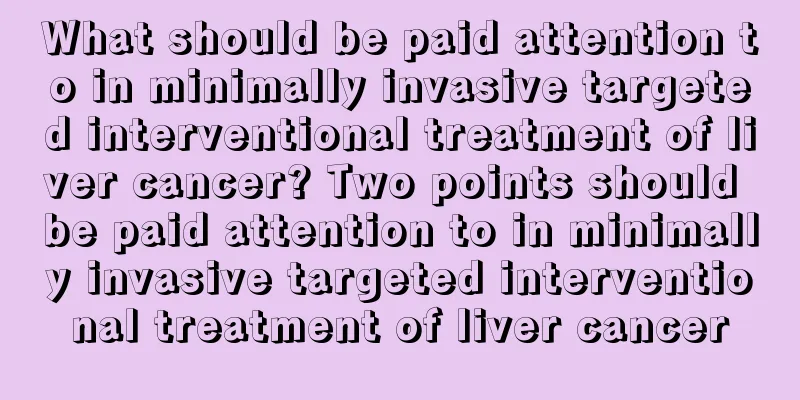What should be paid attention to in minimally invasive targeted interventional treatment of liver cancer? Two points should be paid attention to in minimally invasive targeted interventional treatment of liver cancer

|
Minimally invasive interventional (targeted) therapy is a modern high-tech minimally invasive or non-invasive treatment technology. Under the guidance of medical imaging equipment, special guide wires, catheters and other precision instruments are sent into lesions, blood vessels or natural channels to make clear diagnosis and precise local treatment of lesions in the body. It can be mainly divided into intravascular minimally invasive interventional therapy and non-intravascular minimally invasive interventional therapy, which has the characteristics of no surgery, no pain, fast recovery, good effect and small reaction. Minimally invasive interventional targeted therapy has become the recognized first choice for non-surgical treatment of liver cancer, but to achieve the maximum effect, the timing of treatment must be chosen correctly. Timing of minimally invasive targeted interventional therapy for liver cancer 1. The interval period should be determined according to the specific situation, such as tumor size, iodized oil accumulation, liver function changes, blood count and general condition. Generally, it can be repeated every 4 to 6 weeks. For advanced liver cancer, one embolization cannot completely control tumor growth and requires two or more TACE and/or other treatment methods. 2. Basic conditions for choosing re-treatment: the previous treatment was effective; the tumor shrank; the AFp level was still high or increased; angiography showed that there were still lesions that had not been filled with iodized oil or new lesions; liver function was normal or slightly abnormal, and it was estimated that the patient could accept re-treatment. The general principle is to minimize the number of treatments while keeping the tumor under control and surviving with the tumor, so as to improve the patient's quality of life and reduce the economic burden. |
<<: How to prevent liver cancer? Experts on liver cancer prevention give 4 suggestions
Recommend
What is the cause of cartilage pain
There are a lot of cartilage tissues in our body,...
Benefits of wearing garnet for women
Nowadays, many people wear some accessories, whet...
How to exercise after tendon adhesion surgery?
Tendon adhesion refers to a disease caused by adh...
Only by choosing effective methods can bladder cancer patients receive effective treatment
When a disease occurs, treatment is the most impo...
Can leukoplakia be cured? How to treat it
White spots are also called vitiligo. It is a rel...
How to exercise the frontal lobe of the brain
The prefrontal lobe of the brain plays a very imp...
Does sperm contain bacteria?
There are no bacteria in healthy semen. Of course...
What should patients with heart failure eat? Dietary requirements must be met
While treating heart failure, you should also pay...
Benefits of Meridian Hammer Tap
When you are sitting or standing with nothing to ...
The role of inflammatory mediators in inflammation
What we usually come into contact with are some m...
What can prevent heatstroke and cool down
In summer, the weather is very hot. Many people c...
What should I do if I don’t bring contact lens solution
When we go out everyday, we are always careless a...
How long can you live after recurrence of esophageal cancer after surgery
Esophageal cancer is a terrible disease. Once you...
What should I do if I feel chest tightness and shortness of breath? What foods can help relieve it?
Many elderly people will often experience chest t...
What should I do if my nose gets choked by water while swimming?
In hot weather, everyone likes to go swimming. Sw...









